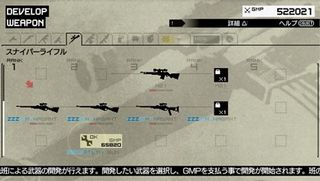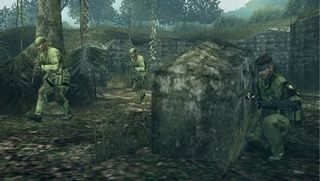8 things you need to know about MGS: Peace Walker
16-hour hands-on teaches us valuable lessons about giant robots, taking enemies alive and Monster Hunter
Of these units, though, the ones you’ll spend the most time with are R&D and Combat. Your R&D techs can do two things: improve your existing weapons and items to make them more powerful and durable (i.e. keeping your pistol silencer from breaking after just a few shots), and develop new technologies based on design schematics you’ll find scattered across the game’s missions.

Above: It's like this, only not in Japanese
These can be developed more quickly depending on how good your personnel is, and they range from new weapons and gadgets to stranger things, like snack foods and canned sodas. In Japan, at least, those will be part of the infamous storm of in-game product placement we reported on a month ago, but during our play session they were just nondescript items with generic labels. Apparently, Konami hasn’t sorted out – and isn’t yet talking about – exactly what this stuff will be in the US.
Meanwhile, your Combat unit seems useless at first, except in the case of Extra Ops missions. Unlocked after you’ve completed a mission, Extra Ops task you with revisiting the mission area to accomplish a specific goal, like finding an item or recruiting a marked person, frequently within a time limit. A lot of these don’t let you play as Snake (he’s busy), meaning you’ll have to spare someone from your Combat team (who won’t be as good as Snake at anything) to take on the mission instead. The good news is that undertaking these missions can unlock cool things you wouldn’t get otherwise.

The further you get in the game, however, the more useful your Combat troops become. Not only does adding soldiers to the unit increases your GMP (basically your R&D funding), but they’re also essential to the Outer Ops mode, which enables you to send groups of mercenaries off-site to tackle specific missions. Once you do, they’ll disappear for the duration of a mission or two, then return with an after-action report that plays out as a non-interactive, turn-based battle between icons representing your troops, and icons representing the enemy.
Your troops tend to show seemingly random judgment during these battles, frequently using RPGs on weak ground troops and then plinking away at tanks with assault rifles, but they’re still surprisingly fun to watch. Also, in addition to earning more GMP for you to play around with, these missions – like Extra Ops – can open up new items you won’t find elsewhere in the game.
5. Co-op makes a huge difference
You can soldier through Peace Walker as a solitary Snake if you want, but the going is a lot easier – and a lot more fun – with a buddy along. Most of the missions only allow you to bring along one co-op partner (four-player opportunities tend to be reserved for boss fights), who can distract guards, watch your back, call in supply drops while you draw an enemy’s fire or simply pool their items with yours (two players means twice as many Fulton balloons, for example).
Sign up to the GamesRadar+ Newsletter
Weekly digests, tales from the communities you love, and more

When the going gets especially rough, you can group up close together to share your health meters, and if you get killed while not in close contact, your partner can track you down and revive you. It’s even possible to clap your hand on your partner’s shoulder and follow them around automatically, in case you’ve got something else that requires your immediate attention.

10 years after Captain America: The Winter Soldier, directors the Russo Brothers share their favorite MCU memories

A former Stardew Valley dev is making their own life sim set in a city, and it boasts some exciting "Wind Waker-style wind whirlies"

Publisher behind one of 2023's biggest Soulslikes announces $60 million "best-ever" year just 3 months after laying off 10% of staff
Most Popular




